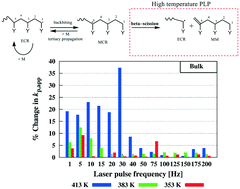当前位置:
X-MOL 学术
›
React. Chem. Eng.
›
论文详情
Our official English website, www.x-mol.net, welcomes your feedback! (Note: you will need to create a separate account there.)
Access to the β-scission rate coefficient in acrylate radical polymerization by careful scanning of pulse laser frequencies at elevated temperature†
Reaction Chemistry & Engineering ( IF 3.9 ) Pub Date : 2018-09-14 00:00:00 , DOI: 10.1039/c8re00171e Anil B. Vir 1, 2, 3, 4 , Y. W. Marien 1, 2, 3, 4 , Paul H. M. Van Steenberge 1, 2, 3, 4 , Christopher Barner-Kowollik 5, 6, 7, 8, 9 , Marie-Françoise Reyniers 1, 2, 3, 4 , Guy B. Marin 1, 2, 3, 4 , Dagmar R. D'hooge 1, 2, 3, 4, 10
Reaction Chemistry & Engineering ( IF 3.9 ) Pub Date : 2018-09-14 00:00:00 , DOI: 10.1039/c8re00171e Anil B. Vir 1, 2, 3, 4 , Y. W. Marien 1, 2, 3, 4 , Paul H. M. Van Steenberge 1, 2, 3, 4 , Christopher Barner-Kowollik 5, 6, 7, 8, 9 , Marie-Françoise Reyniers 1, 2, 3, 4 , Guy B. Marin 1, 2, 3, 4 , Dagmar R. D'hooge 1, 2, 3, 4, 10
Affiliation

|
A novel method to estimate the β-scission rate coefficient (kβ) in radical polymerization of acrylates is introduced, provided that the backbiting and tertiary propagation rate coefficient have already been determined at sufficiently low temperatures at which β-scission is negligible (≪350 K). The method relies on the sensitivity of kβ upon a change of the pulse laser frequency (≪200 Hz) under isothermal pulsed laser polymerization (PLP) conditions in the temperature range between ca. 350 and 415 K, leading to a sufficient variation of the times scales of the radicals involved. These observations are not significantly influenced by macropropagation and thermal self-initiation, as respectively confirmed by in silico testing and experimental data. Solution inflection point data (e.g. solvent butyl propionate) are needed in the lower temperature range (350–410 K), whereas bulk inflection point data suffice in the higher temperature range (410–415 K). The proposed method leads to an estimated kβ value of (4.26 ± 1.8) × 102 s−1 at 413 K with bulk PLP data, suggesting a high propensity of macromonomer formation in acrylate polymerization under high temperature radical polymerization conditions, exceeding the previously suggested levels (kβ = 6 × 100–1.45 × 102 s−1).
中文翻译:

通过仔细扫描高温下的脉冲激光频率,获得丙烯酸酯自由基聚合反应中的β-断裂速率系数†
估计β-断裂率系数(A新颖方法ķ β被引入在丙烯酸酯的自由基聚合),只要该诽谤和第三传播速率系数已在足够低的温度下在该β-断裂是可忽略的决定(«350 K)。该方法依赖于的灵敏度ķ β在等温脉冲激光聚合(PLP)下的脉冲激光的频率(赫兹«200)的变化条件之间的温度范围内约 350和415 K,导致所涉及的自由基的时标有足够的变化。分别由计算机分析证实,这些观测值不受宏观传播和热自引发的显着影响测试和实验数据。在较低温度范围(350–410 K)中需要溶液拐点数据(例如,溶剂丙酸丁酯),而在较高温度范围(410–415 K)中需要足够的整体拐点数据。所提出的方法导致的估计ķ β的(4.26±1.8)×10个值2小号-1在413 K的散装PLP数据,表明大分子单体形成的高温自由基聚合条件下聚合的丙烯酸酯高的倾向,超过了先前建议水平(ķ β = 6×10 0 -1.45×10 2小号-1)。
更新日期:2018-09-14
中文翻译:

通过仔细扫描高温下的脉冲激光频率,获得丙烯酸酯自由基聚合反应中的β-断裂速率系数†
估计β-断裂率系数(A新颖方法ķ β被引入在丙烯酸酯的自由基聚合),只要该诽谤和第三传播速率系数已在足够低的温度下在该β-断裂是可忽略的决定(«350 K)。该方法依赖于的灵敏度ķ β在等温脉冲激光聚合(PLP)下的脉冲激光的频率(赫兹«200)的变化条件之间的温度范围内约 350和415 K,导致所涉及的自由基的时标有足够的变化。分别由计算机分析证实,这些观测值不受宏观传播和热自引发的显着影响测试和实验数据。在较低温度范围(350–410 K)中需要溶液拐点数据(例如,溶剂丙酸丁酯),而在较高温度范围(410–415 K)中需要足够的整体拐点数据。所提出的方法导致的估计ķ β的(4.26±1.8)×10个值2小号-1在413 K的散装PLP数据,表明大分子单体形成的高温自由基聚合条件下聚合的丙烯酸酯高的倾向,超过了先前建议水平(ķ β = 6×10 0 -1.45×10 2小号-1)。



























 京公网安备 11010802027423号
京公网安备 11010802027423号